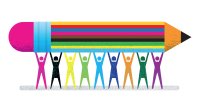How Educators Can Better Support LGBTQ Teachers of Color
Queer teachers from marginalized racial and ethnic groups face unique challenges, but backing from colleagues can help a lot.
Your content has been saved!
Go to My Saved Content.The mainstream conversation surrounding LGBTQ+ issues in American education has mostly revolved around supporting LGBTQ+ students. Although focusing on queer and trans students is absolutely critical and should be prioritized—especially since not nearly enough is being done to support this vulnerable student group—queer and trans teachers should not be forgotten in this conversation. While juggling all the many demanding teacher responsibilities, queer and trans teachers also face many unique and extraordinary challenges as we actively support our LGBTQ+ students, navigate deeply homophobic and transphobic school systems, and constantly grapple with how our queerness and gender identities inform our classroom cultures, our relationships with students and families, and our own practice.
Indeed, being a queer or trans teacher is difficult. However, being both queer or trans and a person of color is even more challenging. Research has clearly shown that teachers of color are being pushed out of the teaching profession at alarmingly high rates. Unfortunately, there are a plethora of reasons that cause many teachers who are Black, Indigenous, and people of color (BIPOC) to leave the teaching profession, ranging from having to endure microaggressions to being expected to be more disciplinarians than teachers. Add these challenges of being a BIPOC teacher to the challenges that come with being a queer or trans teacher, and it comes as no surprise that there is a scarcity of queer and trans teachers of color in the profession. Instead of centering the voices and experiences of queer and trans BIPOC teachers who bring so many assets to schools and classrooms, school communities often overlook teachers with these intersecting, marginalized identities, leaving us feeling unsupported.
The good news is that as teachers and school leaders, we can support queer and trans teachers of color in many ways.
3 Ways to Bolster Queer and Trans BIPOC Teachers
1. Read and inform yourself. Instead of asking queer and trans educators of color about our experiences and challenges, teachers and school leaders can commit to learning about how power and oppression operate, especially along the lines of race, gender, and sexuality. Although most teachers and school leaders don’t mean harm when asking us about our experiences, it is often taxing for us to have to educate our peers about these issues, especially when we already have too much on our plates.
Here are a few reading recommendations to get started:
- “Mapping the Margins: Intersectionality, Identity Politics, and Violence Against Women of Color,” by Kimberle Crenshaw
- Redefining Realness: My Path to Womanhood, Identity, Love & So Much More, by Janet Mock (also watch the television show Pose, directed and produced by Mock)
- Critical Race Theory: An Introduction, by Richard Delgado and Jean Stefancic
- From #BlackLivesMatter to Black Liberation, by Keeanga-Yamahtta Taylor
Delving into these readings would be a good start to help teachers and school leaders in better supporting queer and trans BIPOC teachers, and it would also better equip them to more effectively serve students from intersecting, marginalized backgrounds.
2. Use inclusive language. Language matters. The language that teachers, school leaders, and others with power and authority use in schools matters. Using inclusive language is a tangible way of supporting queer and trans teachers of color. Inclusive language helps avoid biases and expressions that discriminate against groups of people based on race, gender identity, sexuality, and other axes of power. It also helps foster a supportive, inclusive school environment for all teachers and students alike.
The following are some examples of inclusive language that specifically avoids gender:
- Saying friends or y’all instead of ladies and gentlemen or guys
- Saying partner instead of wife or husband
- Saying parent instead of mom or dad
Although using inclusive language is critical, it’s also important to note that inclusive language should be mostly used when referring to people before knowing their pronouns. It’s also recommended to use inclusive language in situations where someone uses nonbinary pronouns (e.g., they/them). Pronouns are the words that we use (other than our names) to address ourselves and others. So, when a queer or trans teacher (or student) asks to use the pronouns they have set for themselves, they are asking others to respect their identity. When colleagues and administrators foster an inclusive culture in which folks are able to disclose their pronouns, both queer and trans teachers and students are able to feel safer and more valued at school.
3. Become an advocate. Queer and trans BIPOC teachers tend to feel incredibly lonely as either the only teacher or one of the few teachers who hold these marginalized, intersecting identities at their school site. In addition to feeling lonely, we have to actively push back on racist, homophobic, and/or transphobic slurs, policies, and practices at our schools. We are usually the ones who take on the extra, unpaid labor in supporting our school’s queer and trans student organizations. Indeed, this is a lot to carry for us, so other tangible ways to support queer and trans teachers of color are by helping us to lead queer and trans student organizations; being co-conspirators with us with in fostering an LGBTQ+ inclusive and anti-racist school culture; speaking up for us in meetings; and taking some of the burden off our plates. We can’t be the only ones doing the work.
Fortunately, there are many teachers out there who have helped us, but we need more help. So who else is ready to roll up their sleeves and work with us?
